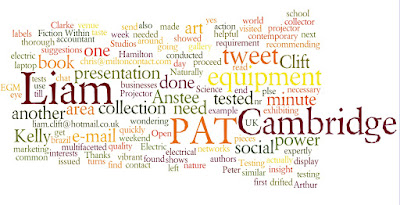 |
| From Wordle-images |
I needed to my laptop and projector PAT tested for a presentation. The venue, a school, made this a requirement for the use of any equipment. I had only till the end of the week to get this done and was wondering how to proceed.
My first action was to send out a tweet:
"I need my Projector to be PAT tested in /nr Cambridge before next weekend. Any suggestions plse e-mail chris@miltoncontact.com #in Thanks!"
Within one minute, yes one minute, I had an e-mail from Kelly Anstee, recommending Liam Clift, Cambridge PAT Testing.
I visited Liam, who was actually having a day off, who expertly and quickly conducted thorough PAT tests on my equipment and issued the necessary labels.
Naturally we also had a chat and found other interests in common. For example, the presentation was going to be at the Cambridge Open Studios EGM. Liam, turns out to be an art collector with his own collection and gallery exhibiting contemporary art from around the world. He had some vibrant pieces from brazil on display.
My eye drifted to his book collection, to find we had a very similar taste in the quality Science Fiction authors, from Arthur C Clarke to Peter Hamilton.
I left Liam with not only my equipment but with another book to read and another insight to the multifacetted nature of businesses in our area.
If you need electrical testing done in the Cambridge UK area, you can contact Liam Clift on 07709432805, liam.clift@hotmail.co.uk.
Kelly Anstee is a helpful accountant at http://www.tyrrellandcompany.co.uk/